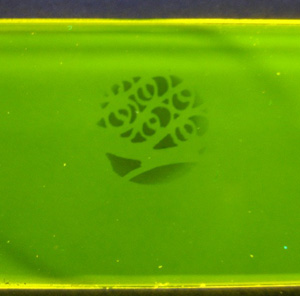Random Lasers in Dye-doped Nanoestructured Silica Gels
Within the class of dye random lasers, laser dyes are used to provide the optical gain amplification whereas the scattering typically comes from a suspension of particles in a dye solution. However, a different approach was followed, by a collaboration with the Group of The University of the Basque Country (Departamento Física Aplicada I, ETSI, Bilbao), to achieve random lasing. The Rh6G dye was embedded in solid porous silica nanoparticles which can be either incorporated into a bulk silica gel matrix or directly dispersed within undoped silica nanoparticles. The advantages of such a material are its solid-state nature, quenched disorder, high laser-like emission efficiency, and the possibility of being functionalized for various applications in the field of biosensors or biotracers.
(a) Normalized emission spectra of the 2% Rh6G-SiO2 nanoparticles dispersed in silica powder obtained at 30 μJ/pulse (point line), 74 μJ/pulse (dashed line), 90 μJ/pulse (thin full line) and 1800 μJ/pulse (thick full line). (b) Pump energy dependence of the corresponding emission linewidths.
S. García-Revilla, R. Balda, J. Fernández, H. Cui, M. Zayat and D. Levy, One- and two-photon laser spectroscopy of silica gel-doped fluorescent nanoparticles, Optical Materials 2009, 31(7), 1086-1091.
S. García-Revilla, I. Sola, R. Balda, L. Roso, D. Levy, M. Zayat and J. Fernández, Two-photon pumped random lasing in a dye-doped silica gel powder, SPIE Proceedings – Optical Components and Materials VII 2010, 7598, 759804-1. ISBN: 978-0-8194-7994-5.
S. García-Revilla, M. Zayat, R. Balda, M. Al-Saleh, D. Levy and J. Fernández, Low threshold random lasing in dye-doped silica nano powders, Optics Express 2009, 17(15), 13202-13215.
S. García-Revilla, J. Fernández, R. Balda, M. Zayat and D. Levy, Real-time spectroscopy of novel solid-state random lasers, SPIE Proceedings 2009, 7212, 72120K.
S. García-Revilla, J. Fernández, Mª A. Illarramendi, B. García-Ramiro, R. Balda, H. Cui, M. Zayat and D. Levy, Ultrafast random laser emission in a dye-doped silica gel powder, Optics Express 2008, 16(16), 12251-12263.
Coatings with Fluorescence Activity (“Nanolambda”)
This project proposes the development of nanotechnological structures and materials that, by their integration onto photonic elements, give rise to devices with a wavelength dependent response. To get selectivity in the response according to λ, work will be carried out to obtain absorbent materials, based on nanoparticles (i.e. quantum dots) and dyes encapsulated in transparent matrices prepared by plasma and sol/gel techniques, as well as bidimensional photonic structures. The photonic elements with which these materials and structures being integrated in Si photodiodes, conventional optical fibres, photonic crystal fibres, as well as other photonic structures. The devices developed in the project were detectors insensitive to the angle of detection and optical fibre sensors based in new transduction techniques. The research intended solving technological problems, as are the wavelength multiplexed diffuse optical communications.
 Photonic structures made by deactivation of fluorescent thin film layers by irradiation with UV-light through masks
Photonic structures made by deactivation of fluorescent thin film layers by irradiation with UV-light through masks
“NANOLAMBDA”: Absorbing layers and quantum dots and photonic structures for the development and optimization of optical devices.
Hybrid Organic-Inorganic Materials for Holographic Applications
The SGG in a narrow collaboration with the LINES – Laboratory of Space Instrumentation – from the Area of Payloads and Instrumentation of the Department of Space Sciences and Electronic Technologies of the INTA is working on the development of two types of organic-inorganic hybrid materials, using the Sol-Gel method, for applications in the field of holography. The first research activitiy is oriented to the preparation of materials in which a great amount of permanent information can be recorded (top Figure) by means of the photopolymerization of a dispersed monomer in a vitreous matrix (photopolymers). The second research line is focused on the development of a photoconductive matrix that allows the storage of information that can be later erased (by heating or by an electric field or by uniform illumination), and rewritten when needed. These matrices could be used as a surface holographic registry media in non-destructive analysis techniques (interferometric holography), in the case of the thermoplastic materials, or as a storage media for large amounts of information, by means of volume holography, in the case of the photorefractive materials. Highly photoconductive properties were achieved for organic-inorganic hybrid sol-gel thin films materials composed on a classical PVK/TNF polymeric mixture entrapped in a SiO2 matrix. The highest photosensitivity obtained, 3.4 X 10-10 cm.W-1.W-1 at E ~ 22 V.mm-1 is in the range of the highest values ever reported for any PVK/TNF based classical photoconductive material (botton Figure).

Optical microscopy picture of the holographic grating
 Photosensitivity evolution as a function of the TNF content.
Photosensitivity evolution as a function of the TNF content.
Gonzalo Ramos, Tomás Belenguer and David Levy, Highly Photoconductive Poly(vinylcarbazole)/2,4,7-Trinitro-9-fluorenone Sol-Gel Material that Follows a Classical Charge-Generation Model, J. Phys.Chem. B 2006, 110(48), 24780-24785.
G. Ramos, A. Alvarez-Herrero, T. Belenguer, F. del Monte and D. Levy, Shrinkage Control in a Photopolymerizable Hybrid Sol-Gel Material for Holographic Recording, Applied Optics 2004, 43(20), 4018-4024.
A. Alvarez, T. Berenguer, D. Levy, M. Zayat, R. Pardo, Dispositivo para la formación de imágenes a color en sensores de b/n basado en materiales sol-gel fotocrómicos. Pat. CSIC-INTA Ref.: #P200700294.
